Scala is a statically typed programming language that integrates object-oriented and functional programming concepts while running on JVM. It features interoperability with Java, reduces boilerplate code through type inference, and supports various programming constructs such as loops and pattern matching. Scala collections are rich, distinguishing between mutable and immutable types, offering a flexible approach to data management and organization.
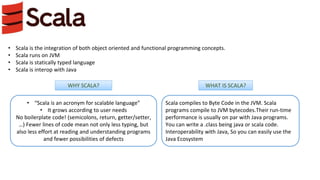
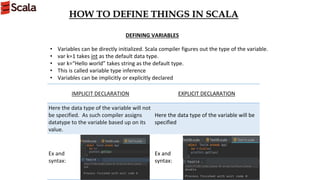
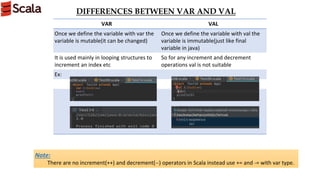
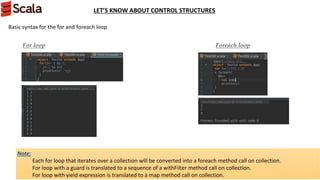


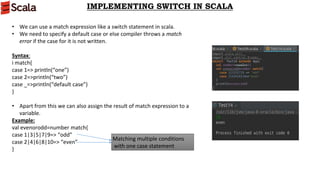

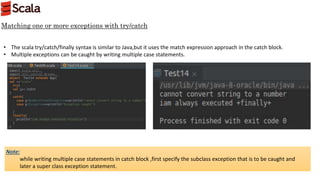
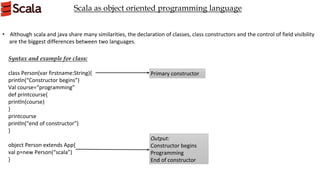

![OBJECTS
• The word object has dual meaning in scala .As with Java ,we use it to refer to an instance of a class,but in scala,it is also
keyword.
• In general an object is regarded as instance of class,but in scala an application can also be launched by using object.
Launching an application by using object can be done in two ways
1.Extending trait app
2.Manually implementing main method in an object similar to java.
1.Extending app trait
Syntax:
object hello extends App{
println(“hello”)
}
2.Implementing main method
Syntax:
object hello{
def main(args:Array[String]){
}
}](https://image.slidesharecdn.com/scala-190206071049/85/Intro-to-Scala-12-320.jpg)
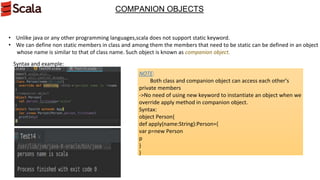



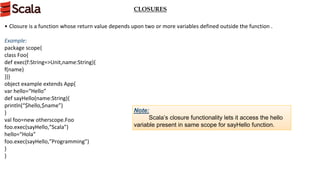
![PARTIALLY APPLIED FUNCTIONS
• Scala like many other programming languages allow partial functionality which is while calling a function
we can send only few arguments and leaving other variables to be passed later.
Example
object scala extends App{
val sum=(a:Int,b:Int,c:int)=>a+b+c
def main(args:Array[String]){
val f=sum(1,2,_:Int)
println(f(3))
}
}
Automatically passes the value ‘3’ as the third argument and returns the sum of three
numbers](https://image.slidesharecdn.com/scala-190206071049/85/Intro-to-Scala-18-320.jpg)


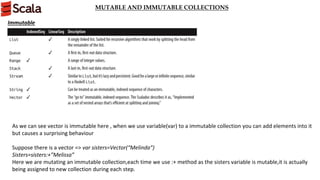
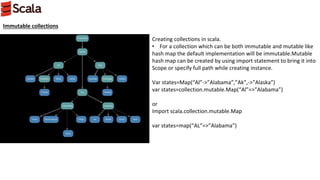

//specifying the particular type
Val list=List.fill(3)(“foo”)//list=List(foo,foo,foo)
Val list=List.tabulate(5)(n=>n*n)//populating the list -list=List(0,1,4,9,16)
In general lists are immutable so to implement mutable functionality we can use ListBuffer and
later convert it into a list.
Example:
var f=new ListBuffer[String]()//Creating an empty list buffer
f+=“apple”
f+=“banana”
f-=“apple”
val flist=f.toList](https://image.slidesharecdn.com/scala-190206071049/85/Intro-to-Scala-24-320.jpg)

Var x=new Array[String](3)//creating an array with an initial size
Multidimensional arrays:
Val rows=2
Val cols=1
Val a=Array.ofDim[String](rows,cols)
A(0)(0)=“a”
A(1)(0)=“b”
Just like a list array is immutable to its size so here we use ArrayBuffer to change
the size of an array.
Example:
Var char=collection.mutable.ArrayBuffer[String]()
Char+=“Ben”
Char+=“ken”
Later arraybuffer can be converted into array bu using toArrray method.
Note:
An array can easily be sorted by
using quicksort algo present in
scala.util.Sorting.quicksort
Syntax:
Val a=Array(“a”,”b”)
quicksort(a)](https://image.slidesharecdn.com/scala-190206071049/85/Intro-to-Scala-25-320.jpg)

//A queue can be created like any other collection.
Q+=(4)
q.enqueuer(5)//can also use enqueue.
Val n=q.dequeue//takes element from head of queue- 1
q.dequeueAll(_.length==1)//removes all elements from queue whose length is one
Similarly dequeueFirst can be used to check on first element in queue and then remove it.](https://image.slidesharecdn.com/scala-190206071049/85/Intro-to-Scala-27-320.jpg)
![STACK
• A stack is a Last-In-First-Out data structure .
• In most programming languages we perform operations on stack by using push and pop methods. Even in scala these
methods are present.
Scala has both mutable and immutable versions of stack.
Mutable stack:
Val ints=Stack[Int]()
ints.push(1)//stack=1
ints.push(2)//stack=1,2
val n =ints.pop//n=2
val k=ints.top//k=1](https://image.slidesharecdn.com/scala-190206071049/85/Intro-to-Scala-28-320.jpg)

